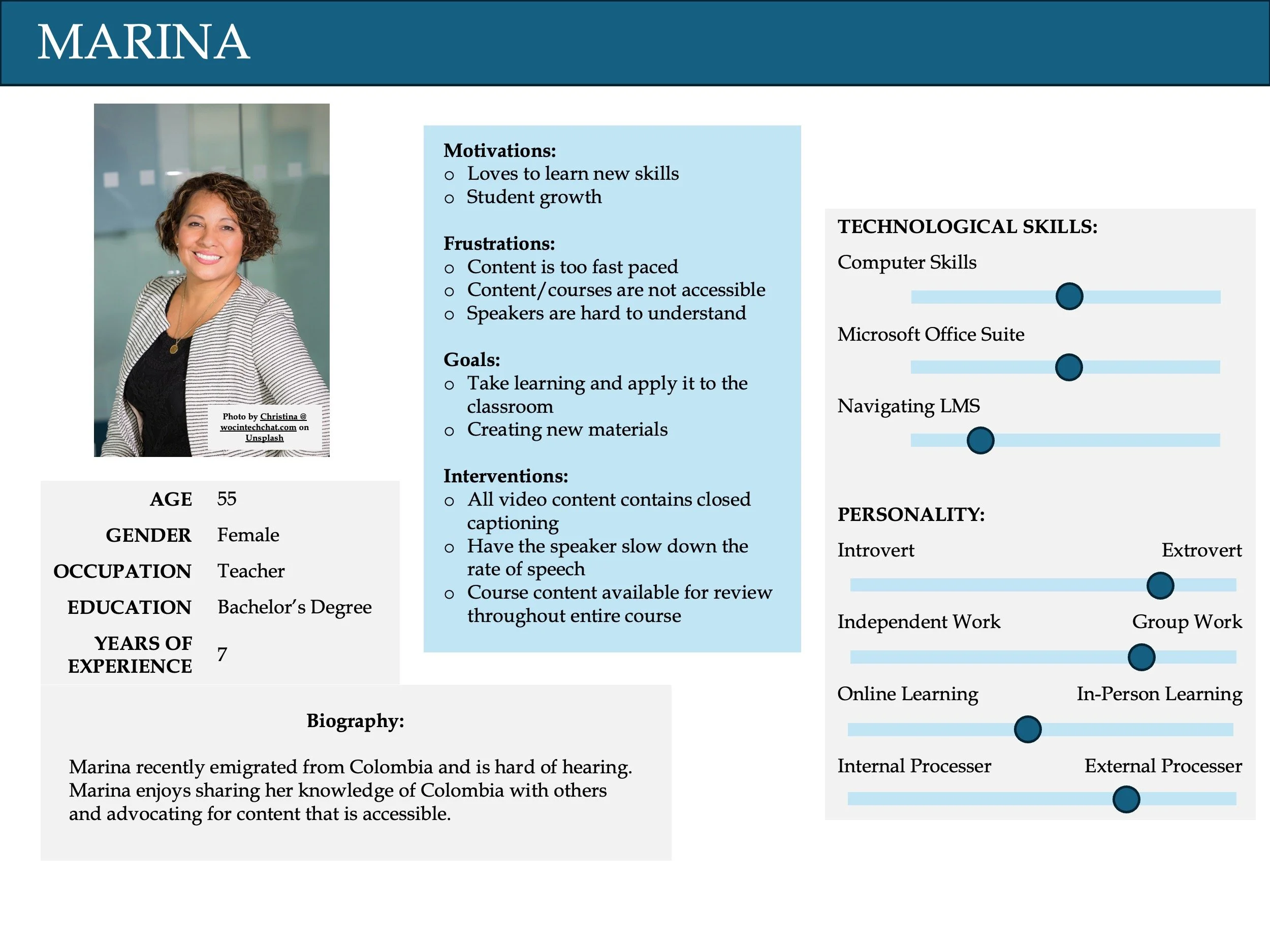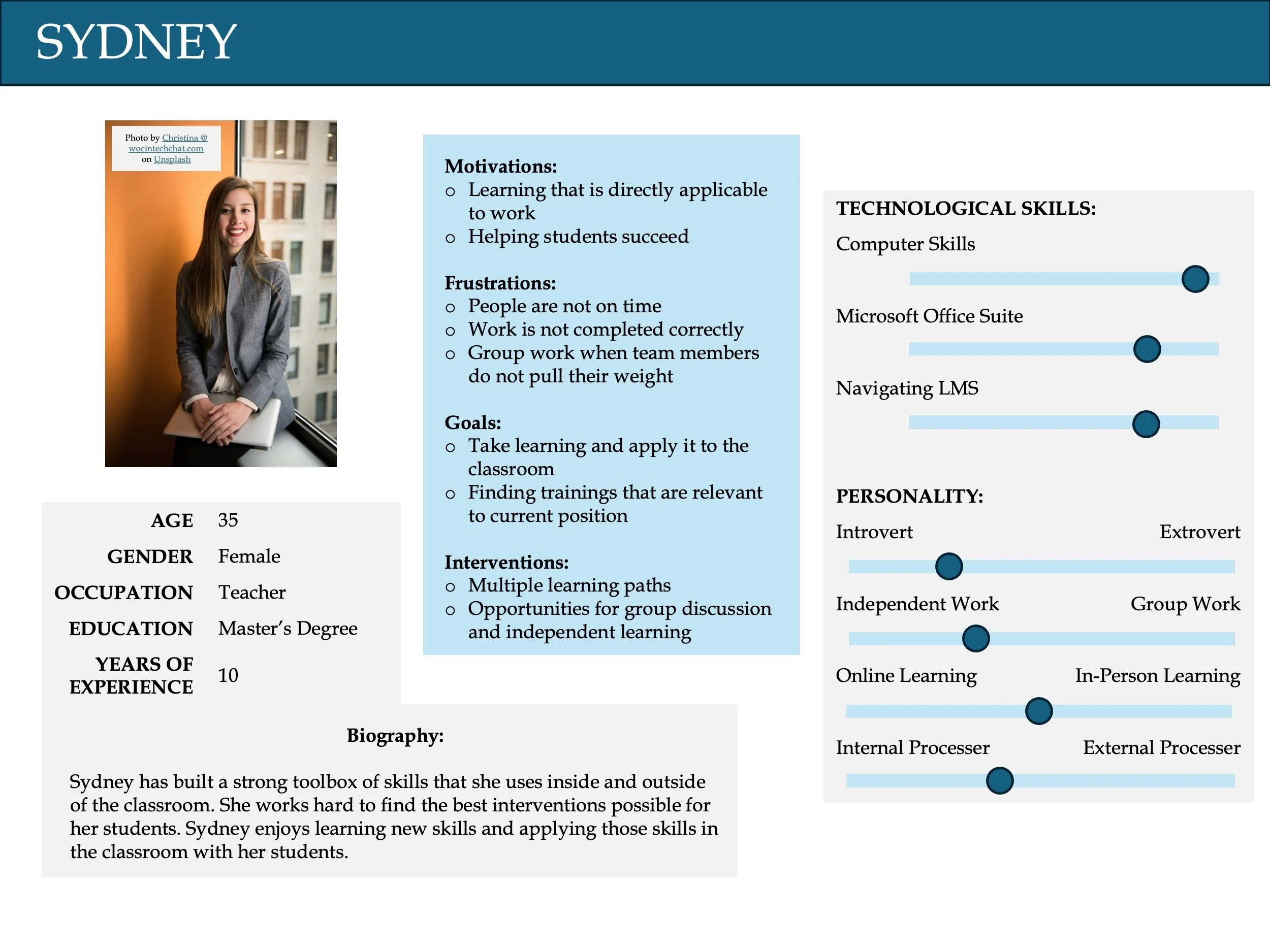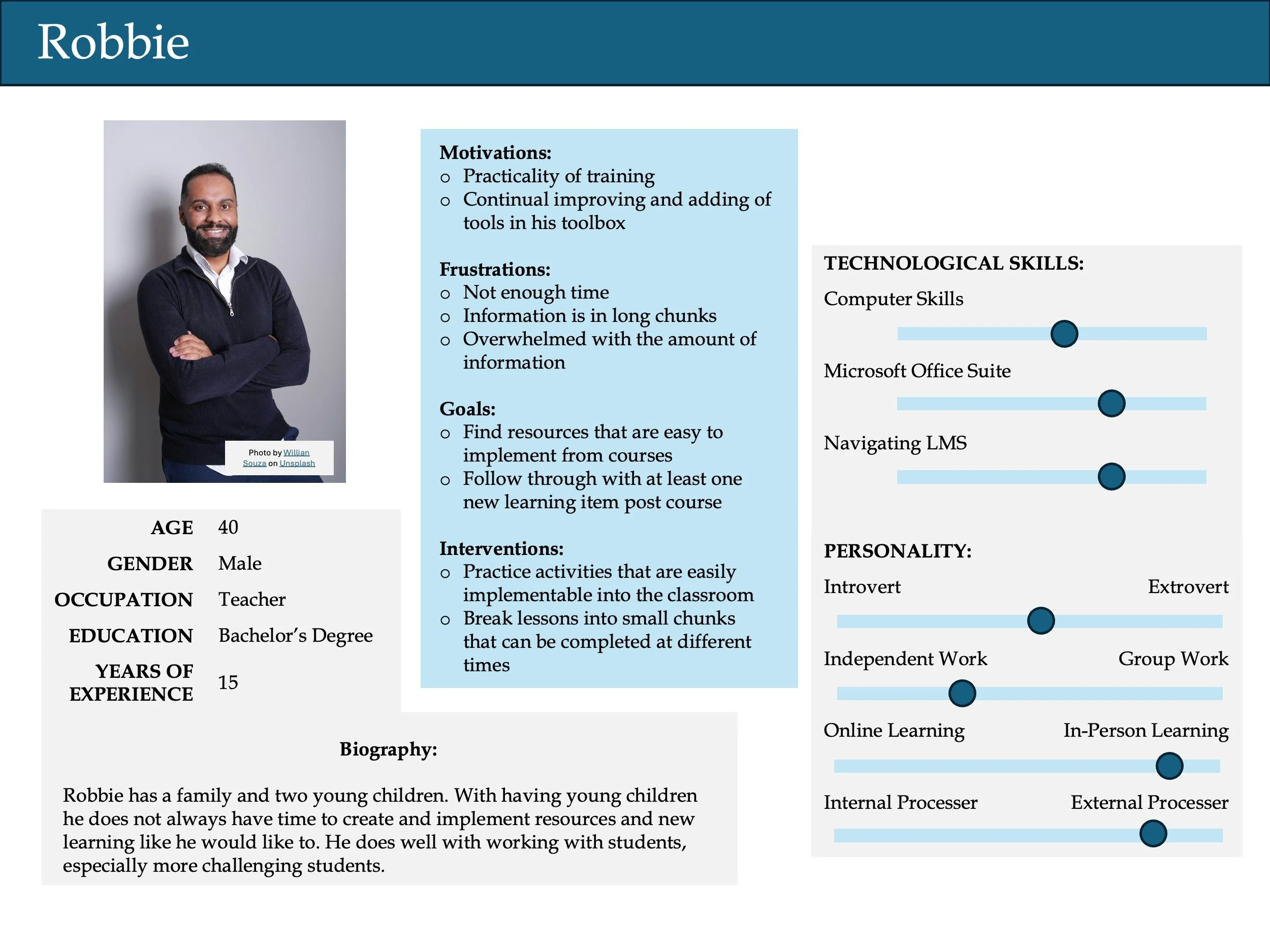e-Learning Courses
Introduction
write an intro description
This brief portfolio features an e-learning project that was created as part of the University of Washington E-Learning Instructional Design certificate and is the sole design of Tara Peters.
Overview: Design and Development
Add info re: project planning as relates to ADDIE process
Included in this brief portfolio are:
Analysis: E-Learning Proposal
Project Proposal
Title: Modeling Effective Visual Supports Strategies in Early Childhood Education
Description: The online training is designed for early childhood educators seeking to enhance their skills in utilizing modeling techniques related to visual supports. Participants will explore the concept of modeling, including its significance in early childhood education, and will review various examples and techniques for effective implementation in their learning environment.
Part 1: Project Scope
This course will consist of five modules. The project will be a completed sample of one of the modules.
Part 2: Background
- Gap: A significant increase in negative behaviors has been noted by early childhood educators. Negative behaviors can be reduced by modeling visual supports in their environment. However, educators are struggling with applying their knowledge of visual supports and modeling in their specific environments.
- Audience: Teachers and Caregivers who work with children ages 3-5
- Training Goal: The training goal is to equip teachers and caregivers with the foundational knowledge, skills, and practical experience necessary to effectively develop and implement a plan using the skills acquired in their respective environments.
- Main Assessment: Each module will include a post-test that requires a minimum passing score of 90% to confirm mastery of the skills. Additionally, there will be various check-in quizzes throughout each module to assess understanding of the recently covered content.
Part 3: Design Approach
- Format/Structure: Asynchronous, self-paced – Organizations will have the option to purchase additional synchronous interactions to enhance the learning experience gained from the asynchronous course.
- Possible Technology: LMS System (Canvas, Moodle), Articulate (Rise, Storyline), AI Voice Audio Technology (TBD)
Part 4: Implementation
- Context (where, when, how): This learning will be advertised yearly to local school districts and childcare centers. Organizations can start the course at any point throughout the year through a LMS system.
- Org Considerations: Learners will have varying levels of access to technology and differing levels of technical skills. To ensure inclusivity and usability, the course content must be accessible on both mobile devices and computers. Since the course will be marketed to organizations such as school districts, it is essential that the learning materials comply with Section 508 requirements.
Learner Personas
The fictional characters below represent four unique learner personas in the education field. Creating the e-learning experience with these diverse individuals in mind allowed me to build an inclusive program that caters to a wide range of learners, not just in a single group.
how does the proposal represent A in Addie
Design: Storyboard
Savvy Start
Summary of Project:
The modeling techniques for social behaviors will be the second module in the course around using modeling strategies to increase positive behaviors. This module will include learning about social behaviors, how to identify the best visual support for modeling a specific scenario, and how to use that tool to improve positive social behaviors. With drag and drop activities and role-playing scenarios, learners will be able to gain hands-on learning to ensure mastery of content.
Explanation of Feedback Used:
I used the feedback from my peers in multiple ways. The biggest change from their feedback was the decision to include a pre-test that will then create a learning path for students. Since the course is intended to only be 20-30 minutes, a post-test will not be included but rather scored quizzes after the interactions to ensure mastery of objectives.
Based on some of the feedback, I included more details and/or examples into the storyboard. For example, one peer asked about the use of audio and including real children in an example or using AI children for the interaction. I had already planned on doing this but did not specifically include that information in my storyboard.
Savvy Start Lessons Learned:
My original project proposal was very large scale and did not have a clear path of where to go. However, with feedback, I was able to narrow down my ideas and start getting a clearer view. One thing that I wish I would have done was go back and create objectives for the project that I am currently working on to help guide things more. However, I am still unsure of the complete path of the module.
It is hard not to overthink the process (both initial prototype and revising the prototype). I had to stop myself a couple of times and review what I was doing as I was trying to determine more of the content in detail which is not needed at this step.
I also found it challenging to complete some of the storyboard when the platform for hosting the module is unknown. I have an idea of what I would like to do but I do not know if I will have access to those resources or not.
I enjoyed reviewing peer storyboards as I was able to gain insight into how different people interpret the storyboard regarding their projects. It also helped me see different designs that I might implement in the future.
I found that once again, I would overthink the feedback that I received from peers. It was helpful though to see how other people perceive the information when they are not aware of the content. Some things that I learned were that the storyboard needs to be very specific in some ways. For example, I had two sections on one slide (due to slide limit), and although I knew they would be different pages, I did not specifically state this. Once again, I had planned on using audio in the branching scenario / role-playing, however, I did not specifically state that.
Savvy Start
Brief description of storyboard 3-4 slides with the original revised
brief explanation of how the storyboard represents the first D in ADDIE
Development: Work Plan
Project Plan:
Title: Module #2 - Understanding Visual Boundaries
Overview:
My project plan will be to convert and update a pre-built module using Articulate Storyline.
My entire course will consist of five modules in total. The module that I will be converting is Module #2: Understanding Visual Boundaries. I previously built this module using the iSpring Suite Max software. My goal is to update the design, interactions, supplemental resources, and/or information to better adhere to best practices in e-learning. I will be using Clark and Mayer’s 12 Principles of Multimedia Learning as a guide during this update.
Platform/Technology: Articulate Storyline
Project Scope: Revised prototype module
Proposed Elements:
During this module, learners will be guided through the definition, interactive activities, a branching scenario with interactions with three students, a matching activity, and a final quiz. The learner will have an option to reflect on their learning during a discussion board post.
Timeline:
July 6 - Branching Scenario Complete
July 8 - Quality Assurance (QA) of Branching Scenario
July 13 - Matching Scenario Complete
July 20 - Updated Branching Scenario based on QA results
July 20 - Summary Slide
July 20 - Quiz
July 27 - QA Entire Module
August 3 - Update Module based on QA results
brief explaination of how the WOork plan represents the second D in Addie
Implementation - Working Proof
Sample Interactive Element
Description of Branching Scenario
include information about the edits made from the prior ispring module and why
30 second video of branching scenario - articulate
30 second video of branching scenario - iSpring
Scope of E-Learning
explanation paragraph about the e-learning platform used, why, and the scope of the e-learning going live
brief explanation of how the working proof represents the I in ADDIE
Evaluation
Visual Supports Course Goals
Course goals and how to measure them
Kirkpatrick Levels
Accordion of what you are learning at each of the 4 Levels
Assessment Techniques and Tools
information from course 3: final project summative assessment
Evaluation Plan
information from course 3: final project summative assessment
Possible sample questionnaire (post course evaluation, etc)
explanation of the evaluation phase in ADDIE
Appendix
Resources and Technology Used
Articulate 360 (Storyline and Articulate Review)
Padlet (online discussion board)
Narakeet (Text-to-Speech Generator)
Smarty Symbols - This resource was created using Smarty Symbols. All rights reserved worldwide."
Microsoft Word / Google Docs
Microsoft Powerpoint / Google Slides
About the Author
***Update re: Independent Presenter
Hello! My name is Tara Peters and I am an eLearning Specialist & Trainer. As an educator, learning specialist, and independent presenter, I operate from a core belief: everyone has a fundamental right to learn and develop their chosen pursuits, regardless of age or ability. My extensive educational background includes a BA in Elementary and Special Education (with endorsements in Early Childhood Education, Early Childhood Special Education, and Reading), and an MS in Special Education with an Early Childhood Education emphasis.
I refined my approach to inclusive learning during 13 years in preschool special education and empowered countless professionals during 7 years as a professional development trainer. My work as an independent specialist and presenter now centers on providing practical strategies that equip individuals to create meaningful change. I'm looking forward to sharing my insights at an upcoming early childhood conference. Complementing this, my completion of the eLearning and Instructional Design certification from the University of Washington in August 2025, enhances my ability to design even more impactful and inclusive digital learning.
When I am not focused on designing engaging learning experiences, I make sure to carve out time for joy, whether it’s relaxing with my cats, basking in the sunshine, solving puzzles, enjoying a game, or embarking on new adventures with my husband.




